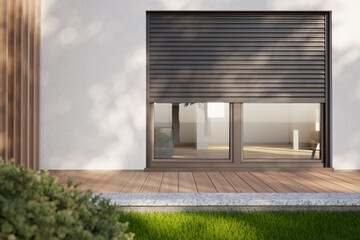When it comes to enhancing the exterior of your home or business and creating a comfortable outdoor space, both external roller blinds and traditional awnings are popular choices. These two options provide shade, privacy, and style, but they differ in terms of design, functionality, and overall performance. In this blog post, we will compare external roller blinds and traditional awnings to help you determine which option is the right fit for your needs and preferences.
- Design and Aesthetic Appeal:
External Roller Blinds: External roller blinds are sleek, modern, and available in a wide range of materials, colors, and patterns. They can be seamlessly integrated into different architectural styles, offering a contemporary and sophisticated look. With their clean lines and streamlined appearance, external roller blinds can complement both traditional and modern settings.
Traditional Awnings: Traditional awnings have a classic charm and can add a touch of nostalgia to your outdoor space. They often feature distinctive shapes and patterns that contribute to a more traditional and rustic aesthetic. If you prefer a vintage or retro look, traditional awnings may be the perfect choice.
- Versatility and Flexibility:
External Roller Blinds: One of the significant advantages of external roller blinds is their versatility. They can be customized to fit various window sizes and shapes, including large expanses of glass. External roller blinds can be operated manually with a crank handle or motorized for added convenience. They are also suitable for both residential and commercial applications, such as patios, balconies, and outdoor dining areas.
Traditional Awnings: Traditional awnings are typically available in fixed or retractable options. Fixed awnings provide constant shade and protection, while retractable awnings offer the flexibility to adjust the amount of shade based on your preferences. However, they are generally more suitable for smaller areas and may not be as adaptable to different window configurations.
- Sun Protection and Energy Efficiency:
External Roller Blinds: External roller blinds excel in providing effective sun protection. By blocking the direct sunlight from entering your space, they reduce heat gain, minimize glare, and protect your furniture and interiors from UV damage. The exterior installation of roller blinds prevents solar radiation from penetrating the windows, making them highly efficient in maintaining a cooler indoor environment. This, in turn, can lead to energy savings by reducing the reliance on air conditioning.
Traditional Awnings: Traditional awnings also offer shade and sun protection, but they are typically mounted on the exterior of windows or above doorways. While they can provide relief from direct sunlight, they may not be as effective as external roller blinds in blocking heat or preventing UV rays from reaching the interior.
- Durability and Maintenance:
External Roller Blinds: External roller blinds are designed to withstand various weather conditions, including rain, wind, and sun exposure. They are often made from durable materials such as PVC, acrylic, or polyester, which are resistant to fading, mold, and mildew. Maintenance is relatively simple, involving occasional cleaning to remove dirt and debris.
Traditional Awnings: The durability of traditional awnings depends on the quality of materials used. Fabric awnings may require regular cleaning, and their lifespan can be affected by sun exposure and weather elements. Retractable awnings require maintenance of the mechanical components and occasional lubrication to ensure smooth operation.
Conclusion:
Choosing between external roller blinds and traditional awnings ultimately depends on your specific needs, preferences, and the aesthetic you want to achieve. External roller blinds offer a modern and versatile solution with excellent sun protection and energy efficiency, while traditional awnings bring a classic charm and flexibility. Consider factors such as design, functionality, sun protection, durability, and maintenance requirements to make an informed decision.


No comments yet